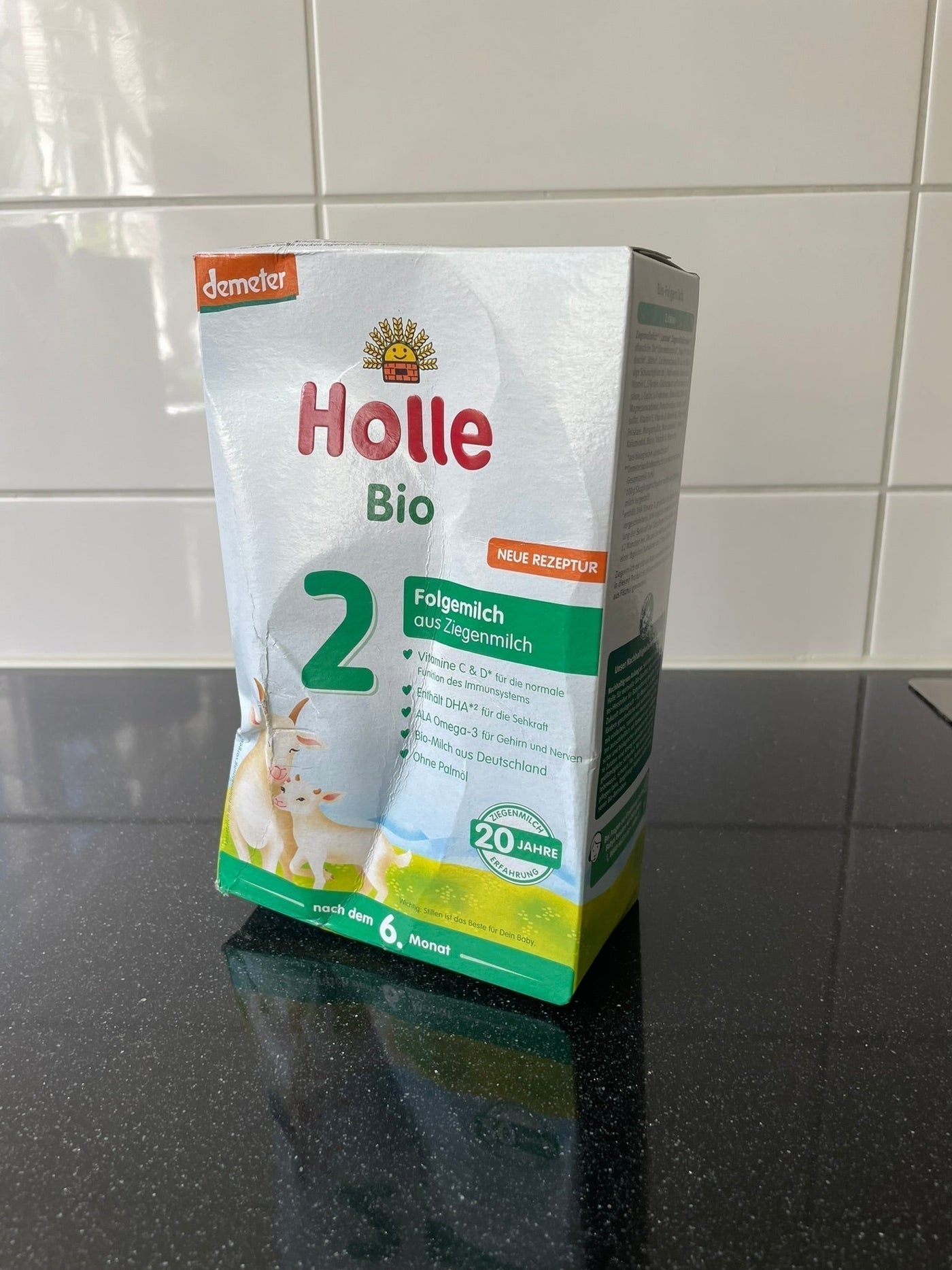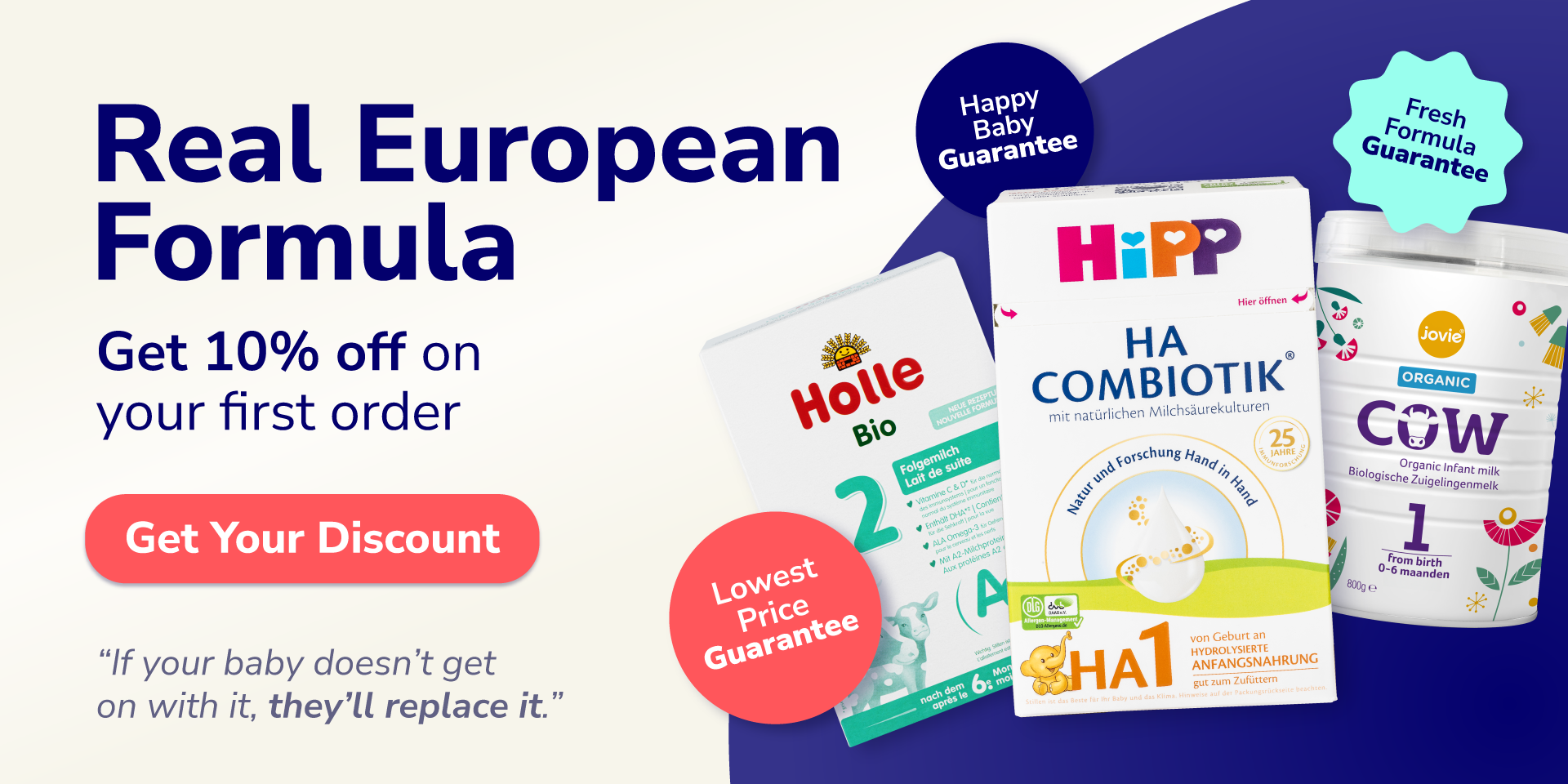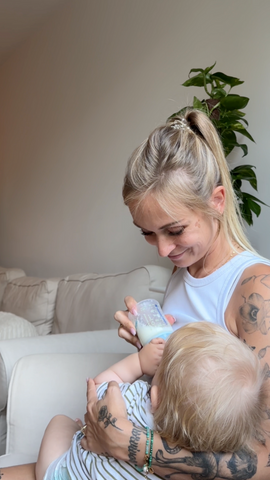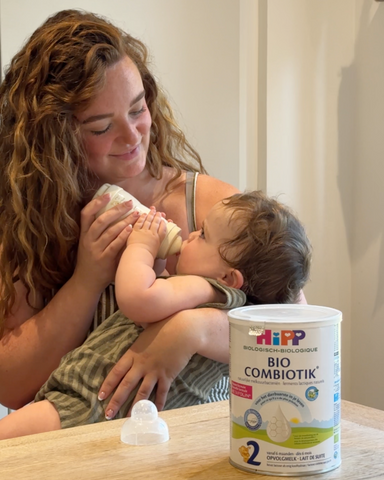
Written by
Stef van Vliet
Published on

If you’re ordering baby formula online, you might be wondering what happens if you receive a dented formula can.
In a store, you’d probably simply pick up another can. But if you’ve ordered online, and had a dented or damaged can delivered? You probably don’t want to have to return it unless it’s really necessary.
Here’s the good news: as long as they’re sent using a reputable carrier (we only use x and x, for example), most formula cans arrive without dents, scratches or damage. If there are any, they’re minor, and the formula inside is absolutely safe to use.
Occasionally, though, formula cans (and boxes) can be damaged in a way that means the formula inside could be dangerous to use.
Formula damage: what to look for, what’s OK, and what’s not
Safe to use: Slightly dented cans and creased boxes.
Cans that have a slight dent, but aren’t punctured or badly damaged are fine to use.
The same applies to creased boxes. As long as the internal foil packaging is intact, they’re safe.
 |

|

|
 |
Not safe to use: Severely dented, damaged and punctured cans and boxes
Severely dented cans will usually have a puncture (even if small), which means they’re unsafe to use. If a box is badly damaged, there’ll usually be a small puncture in the internal foil packaging.
Sometimes it’s obvious when this is the case, and you’ll see formula leaking out. Other times, it may be a tiny hole that’s not immediately visible. Either way, if there’s any puncture at all, there’s a risk of contamination, and the formula isn’t safe to feed to your baby.
What if I can’t tell whether a can or box is badly damaged?
While some cans are so obviously badly damaged that you’ll be in no doubt, this is actually pretty rare.
It’s more likely that you’ll come across a dented can where it’s not immediately clear whether it’s safe to use or not.
How to identify minor damage that doesn’t affect the formula inside
Formula cans:
Minor dents in a formula can are surface-level imperfections that don’t affect the formula powder inside the can in any way. It’ll still be totally safe to use for your baby.
This means small, shallow dents where you can see that the can is not completely smooth, but it’s equally clear that any damage is purely surface level.
These dents could be any shape: irregular dents, small dimples or creases.
You might also find surface scratches or similar damage. These could make it harder to read the ingredients list or instructions, but you can always find those elsewhere. We publish them online, for every formula we stock.
Formula cans:
Just as with cans, minor cosmetic damage to formula boxes isn’t a problem and it’s still safe to feed the formula to your baby. And again, the key thing to determine is whether the formula packaging is punctured in any way.
Boxed formula (such as HiPP) comes with 2 layers of packaging: the outer box and the inner foil. A creased, scratched or even split box is fine, as long as the internal foil isn’t also damaged or punctured.
Because cardboard is more easily damaged than a metal can, you might find it’s more common to see minor damage to the outer box. You might also find that the cardboard sometimes gets wet in transit. In either case, it’s fine to use the formula as long as the internal foil pouch is still intact.
Major damage: when to throw away your formula
You’ll need to throw away your formula if there’s any sign of the kind of damage that could mean the formula is contaminated. Feeding your baby contaminated formula could cause them to become sick, so it’s not worth risking if you’re in any doubt at all.
And if you bought it from us, of course, we will replace it, though it’s worth noting that this kind of damage is rare.
Formula cans:
There are 3 kinds of damage indicating contamination that you might see in your formula can:
-
A puncture or hole in the can, foil seal. This should be fairly obvious to see, and you may find that formula is even leaking out of the can. Be careful though, if there are significant dents, to check for small punctures that might not be obvious at first glance.
- A bulge in the can or foil seal. Formula is vacuum sealed, so a bulge like this indicates that air (and therefore contamination) has got into the can.
- Damage, including dent or rust patches, on the seams of the can. Even if you can’t see a puncture hole, these are the weaker parts of the can, so if there’s damage there, it’s more likely to have caused contamination than if it’s elsewhere.

Formula boxes:
As with cans, the key thing is to check for any punctures or breaks in the seal that would allow contamination into the formula. Here are 3 things to look for:
- Obvious holes or punctures in the foil bag inside the box. You may see formula leaking out, but check carefully so that you don’t miss any small punctures.
- Moisture or patches of discoloration, either on the box or the foil pouch. These are signs that contamination has got in somehow, and it’s best to throw away the formula rather than take a risk.
- Damage along the seams of the foil pouch. These are the weakest areas and so even if you can’t see a puncture hole, damage here is much more likely to lead to contamination.
Are damaged formula cans different from other types of canned food?
In a word, yes.
Most canned or packaged food isn’t completely dry, in the way that formula is. A can of soup, or vegetables, or beans, is wet. The cans are designed differently to formula cans, which must be kept completely dry.
Formula cans are coated in a material that keeps the formula powder inside completely dry, as well as protecting it from excess heat.
This means that formula cans are stronger than most food cans, and minor damage is less likely to be a problem or to lead to contamination.
Formula can damage vs other types of can
The construction of formula cans means that the damage you might see to them is different to the damage you might see to other types of cans.
- Most canning processes use pressure to help preserve the food inside the can. This might mean that dents lead to damage to the food inside and may cause the can to bulge. By contrast, formula is dry, loose and powdery. There’s no pressure in a formula can, and so a minor dent has no impact on what’s inside.
- All types of cans are slightly different in their thickness, strength and ability to resist damage. All will be designed specifically to preserve their contents, so a formula can will be different to a soup can, but a soup can will also be different to a tuna can.
- Formula milk must stay 100% dry, or it becomes unusable immediately. Whereas other types of canned food could safely be used, even if the can is punctured.
Is it ever safe to use formula from a badly damaged container?
Given that babies could become sick quite easily if they are fed contaminated formula, we wouldn’t recommend taking any risks with significantly damaged formula cans and boxes.
In particular, never use formula from a can that has:
- Very large dents
- Punctures or leaks of any size
- Bulges
- Rust
- A broken seal
For boxed formula, look for any kind of damage to the inner foil pouch. Damage to the outer box isn’t usually an issue in itself, but even minor damage to the foil pouch could be a problem. Look for:
- Punctures or leaks
- Significant damage to the foil
- Any signs of moisture inside the pouch
Remember that babies’ immune systems are still developing, and so it’s far better to be cautious than not.
As well as checking for damage, it’s a good idea to make sure that you check the expiration date on the formula. And if you’re buying a European brand, be aware that the date format used in Europe is different from that used in North America. You’ll find the day of the month stated before the month, so that October 5 2020 would be written 5/10/2020 rather than 10/5/2020.
What happens if I get a damaged formula can or box from Zen Organic Formula?
If this happens, contact us straight away and we’ll happily replace any formula that isn’t safe for your baby.
If you’re not sure whether it’s safe, use the examples and pictures above to help. Or let our customer service team know you’re unsure. We’ll always replace if there’s any doubt.
The vast majority of the time, the formula we send out arrives undamaged, and within days. Or with minor cosmetic damage that doesn’t affect its safety.
Why we’re able to ship your baby’s formula with confidence:
- We have our own warehouse, and package every box and can ourselves. Using only strong, high-quality packaging designed to prevent damage.
- European regulations demand strong, durable packaging that helps protect your formula.
- When packaged formula leaves our warehouse, it’s sent only with trusted carriers who we know will handle with care: PostNL, UPS, DHL and FedEx.
Reasons formula occasionally arrives with damage:
- Customs officials sometimes unpack and inspect packages when they cross the border. We can’t guarantee that they’ll always repack them as carefully as we would.
- Human error happens. Even the very best delivery carriers will occasionally drop a box of formula.
- Bad weather, especially rain, can mean that formula packages get wet, which can weaken them.
None of these things should mean that your baby’s formula arrives with anything more than minor cosmetic damage. But if it does, we’re here to help with an immediate replacement.
A quick reminder: when formula can damage is OK, and when it’s not
Most of the time, a damaged formula can or box is totally fine and safe to use.
Very occasionally, formula might arrive with more significant damage that means you should throw it away.
Formula is unsafe if it comes in:
- A punctured or leaking container
- A bulging can
- A container that is damaged along the seams
- A rusty can
- A container that shows any signs of moisture inside
- A container with a broken seal
Thanks to careful packaging, this kind of damage is rare.
To have clean, nutritious organic formula sent direct to your home, browse our store.




